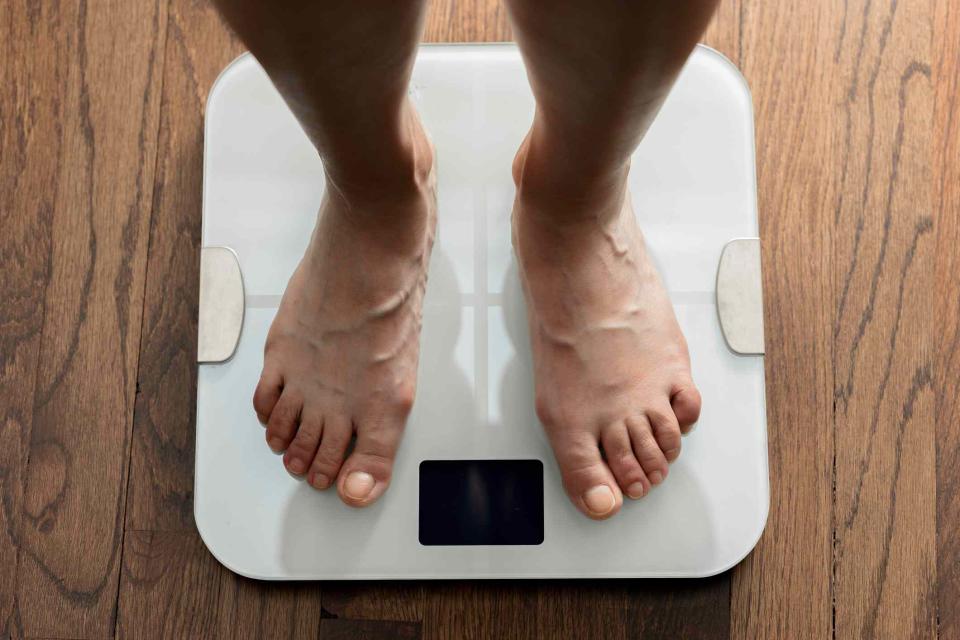Bioelectrical Impedance Analysis: Should You Try It?
Using a BIA Scale Can Help You Reach Your Fitness and Weight-Loss Goals

OsakaWayne Studios / Getty Images
Fact checked by Adah ChungMedically reviewed by Anisha Shah, MDFact checked by Adah ChungMedically reviewed by Anisha Shah, MD
Bioelectrical impedance analysis measures body composition based on the rate at which an electrical current travels through the body. Body fat (adipose tissue) causes greater resistance (impedance) than lean mass and slows the rate at which the current travels. Bioelectrical impedance analysis (BIA) scales estimate body fat percentage using bioelectrical impedance analysis.
You may have seen body fat scales on store shelves or online that use bioelectrical impedance analysis. Because the scales can be expensive, you have probably wondered what bioelectrical impedance analysis is and if it is worth paying for. Below is more to help you decide.
Related: Fat-Free Body Mass Benefits
Definition of Bioelectrical Impedance Analysis
While "bioelectrical impedance analysis" sounds technical, BIA devices use straightforward technology. They measure the rate at which a painless low-level electrical current travels through your body.
Different tissues in your body allow the electrical current to travel at individual speeds. Fat is more resistant than muscle or water, so the higher the resistance, the higher the body fat percentage calculation is likely to be. Most scales measure an estimate of your total fat, muscle, water, and bone in weight and percentage.
Based on that rate, a calculation is used to estimate fat-free mass. The device then uses other data such as your height, gender, and weight measurements to determine your body fat percentage.
Related: Body Composition: What It Is and Why It Matters
Types of BIA Devices
There are different types of bioelectrical impedance analysis devices, but each requires two contact points. On a handheld device, the two points are your two hands (called hand-hand BIA). The two contact points on a typical BIA scale are your two feet (called foot-foot bioelectrical impedance analysis).
This means that when you use the device, you place each foot on a pad and the current travels through your body between your feet. There are also hand-to-foot BIA devices, as well.
Takeaway
Many of the newer models of bioelectrical impedance analysis scales link with a smartphone app so you can track your progress over time.
The price of your bioelectrical impedance analysis scale will depend on how sophisticated the product is. Some scales use more than one frequency and more advanced algorithms to provide a result. Some offer segmental fat analysis, meaning you can get body fat measurements for each leg, arm, and belly. These are factors to consider when shopping for the best body fat monitor to fit your needs.
Some experts say that segmental fat analysis (using hand-foot BIA) is more accurate because hand-hand devices primarily measure the upper body, while foot-foot scales primarily measure the lower body.
Is BIA Safe?
Bioelectrical impedance analysis devices are considered safe for most people. However, BIA should not be used by anyone with an electronic medical implant, such as a heart pacemaker or an implantable cardioverter defibrillator (ICD). Also, most device makers recommend that pregnant people not use the products.
Related: From Basic to High-Tech, We Tested the Best Bathroom Scales for Every User
Accuracy
Some studies showed that bioelectrical impedance analysis is a reasonably accurate method for estimating body fat. However, these research studies generally do not test the scales you find at the store.
Experts generally agree that the accuracy of the measurement depends, in part, on the quality of the device. In addition, other factors may affect a reading when you use a bioelectrical impedance analysis scale.
Body weight: BIA may be less accurate in people with obesity.
Hydration level: Dehydration may cause fat-free mass (muscle and bone) to be underestimated.
Recent exercise activity: High-intensity exercise may affect the accuracy of bioelectrical impedance analysis readings.
Training load: Some scales have a setting for athletes who train more often. The settings are intended to increase accuracy.
Recent food or drink intake: The results of a study suggest that BIA may be more accurate after overnight fasting.
Some researchers also say that ethnicity can affect the accuracy of bioelectrical impedance analysis measurements. Overall, studies show that this method is not extremely accurate. Although it may be able to track change over time, your results are unlikely to reflect your actual body composition.
Is a BIA Scale Right For You?
Even if you get an accurate reading on a bioimpedance scale, the number represents an estimate of your total body fat percentage. Bioelectrical impedance analysis does not accurately measure your total body fat. Most scales also cannot tell you where fat is located on your body.
Even though many factors can affect your reading accuracy, a regular bioelectrical impedance analysis scale can show changes in your body fat over time. The actual number may not be perfect, but you can still track changes to your body composition.
Related: Body Mass Index: Healthy and Unhealthy BMI Values
A Word From Verywell
Because many BIA scales offer several features for a reasonable cost and are a quick and easy way to estimate body fat percent, body fat scales that use bioelectrical impedance analysis are a worthwhile investment for consumers who are curious about their body composition.
Keep in mind that they are not likely to be extremely accurate but you can use them to track changes over time. Another method of tracking your body composition can help get a better picture of your measurements. It's also wise to understand that there is more to health than your body fat percentage or weight, and these scales are only a tool, not a reflection of your general wellness.
Read Next: We Tested the Best Smart Scales to Help You Track Progress and Stay Motivated
Read the original article on Verywell Fitness.

